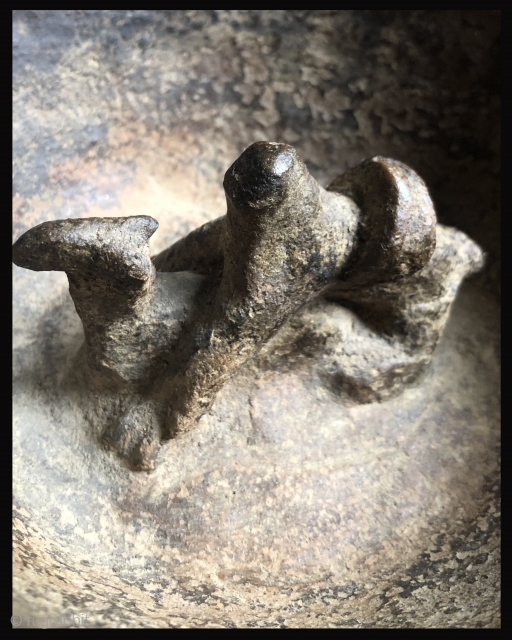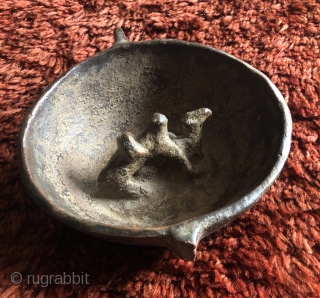Back
Ceramic libation vessel with mating llamas. Bolivian altiplano region. 19th century or before. This bowl shows two llamas mating, an obvious reference to fertility and prosperity. In a society of pastoralists and subsistence farmers increasing the size of one’s herd was of paramount importance. Over millennia - generation after generation, the Aymara carefully bred llamas and alpacas primarily for their fiber. They wove exceedingly beautiful textiles in part by selectively breeding their animals for the finest fiber. Following the conquest in the 1500’s, a large percentage of their animals were lost due to the resultant depopulation of both animals and indigenous people in the region. The quality fiber that the Aymara once treasured lost some of its finest qualities. Though alpaca is still considered among the finest animal fiber in the world, it is but a shadow of what it once was before the conquest. The Aymara also utilized camelids for food, as pack animals and for the manure used to enrich and fertilize altiplano soils. Manure was also burned for fuel in the near treeless environment of the high altitude Lake Titicaca Basin. For the indigenous peoples of the altiplano, these animals were the lifeblood of the culture. Ancient stone carvings of camelids from as early as 1500 b.c. were found scattered throughout the altiplano region and attest to the reverence in which these animals were held.
The llamas in the center of this vessel are shown mating. The male llama had its head broken off a long time ago, as indicated by the softening of the edges around the break. As the bowl is quite dense and hard, this could only happen with the passage of time. It is not clear just how old this bowl is, but it must be quite old. The male is shown with a pack on it’s back that represents a bundle of textiles and coca leaf and other sacred objects wrapped in a larger textile and tied on to the animal’s back. The Aymara make a special occasion out of breeding their best animals - going so far as to dress them up in textiles for the occasion. The bundle also refers to the ability llamas have of carrying burdens of up to 90 pounds of trade goods and food stores on their backs for transport. For the Aymara the Llama is considered to be a family member like a child and an ancestor and protector.
This vessel is one of the only ceramic libation vessels i have seen. Almost all others are made from wood. This bowl has what appears to be a coating of dry and hardened ceremonial residue inside. The clay of this vessel is dark and dense with golden pyrite specks throughout which is typical of certain altiplano clays used in pots from nearly every era. Because of the explicit and evocative nature of the imagery of this bowl as related to the purpose of the Animal Increase Rite and because this example is ceramic rather than wood, this piece is quite rare and very collection worthy even with the loss of the male’s head.
Included here are images of three other libation vessels. All are excellent examples.
price:
Inquire
- Home
- Antique Rugs by Region
- Category
- Profiles
- Post Items Free
- Albums
- Benaki Museum of Islamic Art
- Budapest: Ottoman Carpets
- Gulbenkian Museum
- Islamic Carpets. Brooklyn
- Islamic Textiles. Brooklyn
- Konya Museum: Rugs
- MKG, Hamburg
- MMA: Caucasian Carpets
- MMA: Mamluk Carpets
- MMA: Mughal Indian Carpets
- MMA: Ottoman Carpets
- MMA: Safavid Persian Carpets
- MMA: Turkmen Rugs
- McCoy Jones Kilims
- Ottoman textiles. Met
- Philadelphia Museum
- Rugs and Carpets: Berlin
- Seljuqs at the Met
- TIEM, Istanbul: Carpets
- V&A: Classical Carpets
- Vakiflar Carpets: Istanbul
- Baluch Rugs: Indianapolis
- Gallery Exhibitions
- Jaf an Exhibition
- Alberto Levi Gallery
- Andean Textile
- Christie's London: 2016
- Francesca Galloway
- HALI at 40
- ICOC Washington, DC 2018
- Jajims of the Shahsavan
- London Islamic Week April, 2018
- Mongolian Felts
- Navajo Rugs: JB Moore
- Persian Piled Weavings
- SF Tribal & Textile Art Show 2020
- SF Tribal 2019
- Sotheby's: C. Alexander
- Turkish Prayer Rugs
- Turkmen Main Carpets ICOC 2007











